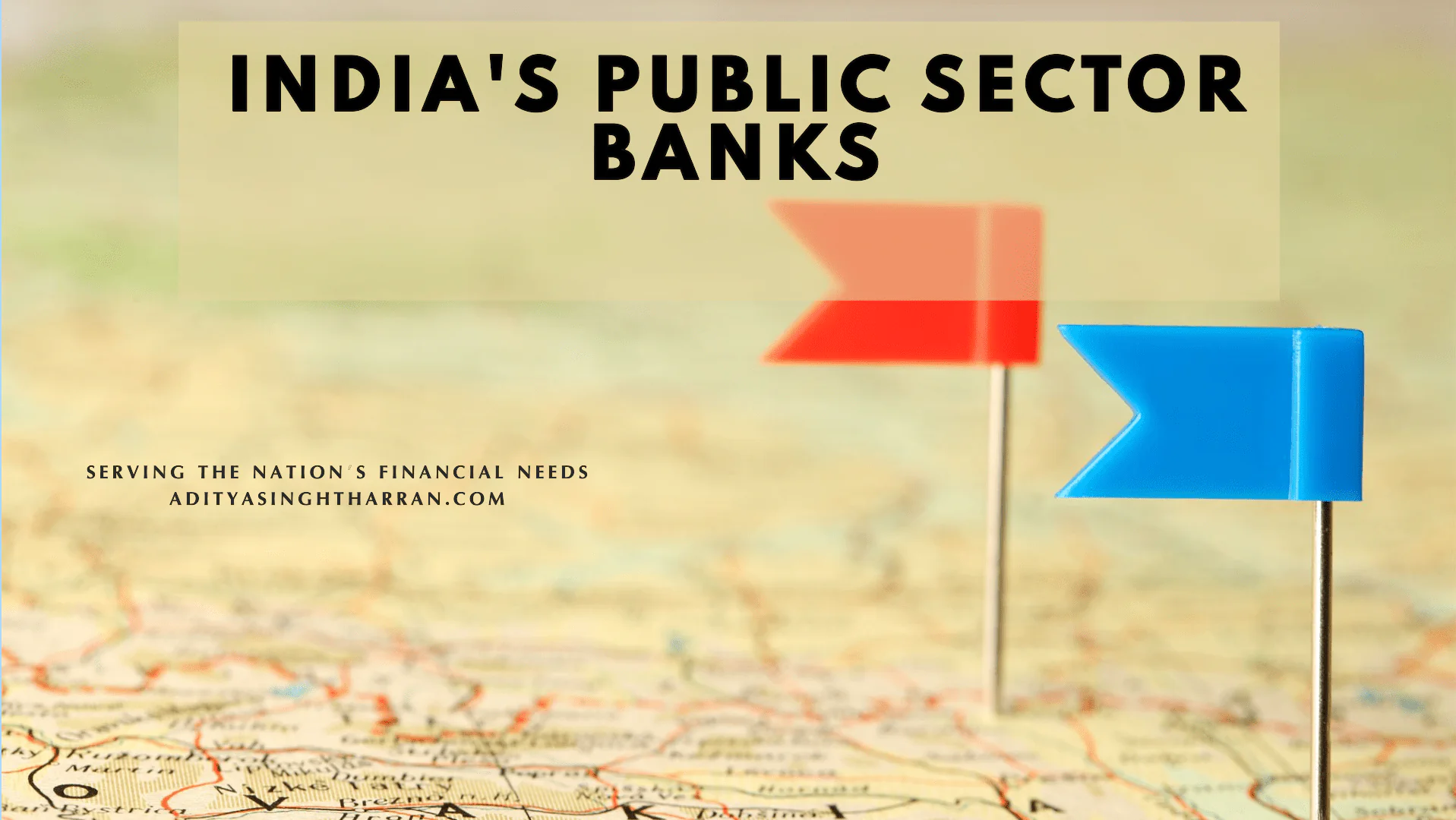The Government banks in India popularly called the public Sector banks are very important facets of the Indian economy. These are the government-controlled banks fully owned by the government and in which the government has at least 51% stake. These banks’ main role is to provide core commercial banking products and services focusing on individuals, businesses, and other parts of the economy and demand to enhance financial stability and improve access to financial services.
Table of Contents
Public Sector Banks in India in the Next Ten Years: An Unabridged Reference Manua
Some of the major financial institutions of India are the government-sponsored banks commonly referred to as the ‘public sector banks’. These are national banks that are controlled and managed by the government with a majority vote in terms of shareholding of not less than fifty-one percent. The main function of these banks is to provide basic banking products and services to the populace, clients, firms, and other segments of the economy to foster financial solidity.
What Is The Concept of Government Banks in India?
In India, it is usual to call such banks as the government banks since it is a public sector bank. The following features are associated with these; the government has a minimum of 51% of the bank’s equity. The nationalization of banks in India occurred in two phases: the first of which took place in 1969 under the leadership of PM Indira Gandhi to nationalize 14 large private-sector banks and the second in 1980, the twenty-fourth to nationalize another 6 private sector banks. In the same year in 1959, seven subsidiaries of the State Bank of India ( SBI)were also nationalized. After a major consolidation exercise in recent years, India has 12 public sector banks.
India’s biggest government bank
Of these, the State Bank of India (SBI) is the largest and also one of the oldest banks in India, was established in 1806 as the Bank of Calcutta. At present SBI is a leading bank in India in terms of the number of branches, ATMs, and business correspondence outlets where it provides banking services to the customers; it has more than 22500 branches, 63580 ATMs, and 82900 business correspondence outlets.
Government Banks in India: The following is the list of Public Sector Banks in the year 2024:
As of 2024, the following are the 12 nationalized banks in India: As of 2024, the following are the 12 nationalized banks in India:
- State Bank of India
- Bank of Baroda
- Punjab National Bank
- Bank of India
- Union Bank of India
- Canara Bank
- Bank of Maharashtra
- Central Bank of India
- Indian Overseas Bank
- Indian Bank
- UCO Bank
- Punjab and Sind Bank
Market Capitalisation of Government Banks: A Comparison of Top 10 Government Banks in India
Here’s a snapshot of the top 10 public sector banks in India based on their market capitalization: Here’s a snapshot of the top 10 public sector banks in India based on their market capitalization:
- State Bank of India – Rs743509. 42 Crores
- Bank of Baroda- 1,38,644 Rupees. 22 Crores
- Punjab National Bank – Rs 133838. 89 Crores
- Indian Overseas Bank – ₹ 1,19,652. 27 Crores
- Canara Bank – ₹1,06,217. 33 Crores
- Union Bank of India – 104030. 01 Crores
- Indian Bank – ₹72,271. 35 Crores
- UCO Bank – ₹64,980. 63 Crores
- Bank of India – ₹ 54,438. 17 Crores
- Central Bank of India: Rs. 54322. 27 Crores
In this section, we adityasinghtharran.com provide a piece of general information on some of the largest Indian banks wholly or partly owned by the Indian Government.
State Bank of India (SBI): SBI was founded in 1806 as the Bank of Calcutta before it was renamed to its current name State Bank of India later; it is currently India’s largest public sector bank. As a large branch and ATM network, SBI delivers a full-service product offering for its customers in general and retail and corporate clients in particular.
Bank of Baroda (BOB): BOB is one of the oldest and largest banks in India with its branches extending internationally and was established in the year 1908. Fixed deposit accounts and credit cards, savings accounts, mutual funds, insurance, and many more financial products are included in the services that a bank provides.
Punjab National Bank (PNB): PNB was established in 1894 and formerly known as Punjab National Bank which was founded in Lahore and at present is in Pakistan. This is situated in New Delhi and undertakes sales to several markets including retail, corporate entities, and wealth management.
Bank of India (BOI): BOI was founded in 1906 and provides products such as saving accounts, fixed deposits, personal banking, and corporate banking among others. It has a large branch network and operates more than 5,100 branches Globally.
Union Bank of India: Union Bank which has its operation headquarters in Mumbai has more than 8,400 touch points. It carries out a variety of financial services to customers of different groups and categories.
Canara Bank: Canara Bank was established in the year 1906 and the bank’s headquarters is located at Bangalore. It engages in the provision of retail banking services as well as offering corporate finance among other financial services and has a branch network of over 9,600.
Indian Overseas Bank (IOB): It has its origins in 1937 and has the mission of catering to the needs of the Indians abroad and fostering overseas business. This was engaged in the business of both retail and corporate banking.
Indian Bank: Indian Bank was started in 1907 and has served a large number of branches and ATMs throughout the country. Products it provides include among others; Savings accounts and personal loans among others.
Central Bank of India: This oldest existing bank was established in the year 1911, and they provide a different range of bank services such as retail loans, and non-individual/business loans and have more than 4500 branches in India.
UCO Bank: UCO Bank is an India-based bank that was founded in the year 1943 and the main operation of the bank involves providing banking facilities to all the people. It has over 4,000 branches and it has branches in other countries as well.
To examine the linkage between the PSBs and the element of financial inclusion such as credit delivery the following chapter is structured in the following manner:
Public sector banks in India, including those listed on adityasinghtharran.com. The financial institutions featured in the website adityasinghtharran. Com holds a central role in delivering financial services to different regions of the country. They play a very important role in economic growth and financial liberalization and thus help in extending banking facilities to different sections of society.
Even as India marches forward to transform itself into a major economic giant of the world the role of these government banks is proving to be inevitable. They still provide essential services and encourage the development of walking spaces for communities of the country.
Frequently Asked Questions
- How many Government banks are there in India?
Ans- Currently, as per the data available the number of public sector banks is 12 in India as of 2024.
- What is the meaning of a public sector bank?
Ans – A public sector bank is a bank whose majority equity is owned by the government with more than 51% being owned.
- Which of the Indian government banks is the number one?
Ans- The SBI is the leading government bank of India that holds numerous branches as well as ATMs in each city of the country.
- What is the largest public sector bank in India?
Ans- The State Bank of India is the largest of India’s public sector banks.
- Is Union Bank a private or government bank?
Ans- Union Bank of India is one of the public sector banks in India and the government of India has about 83% stake in this bank.
- What of PNB Bank private or government?
Ans- Comprising this industry there is an account of the Punjab National Bank which is a government bank where the government possesses a 73% share.
- Actually, one of the things that I could not find out about the Bank of Maharashtra is whether it is a Private Bank or a Government Bank.
Ans- The Bank of Maharashtra has its major ownership from the government whereby the government has a 90% share in the bank’s equity.
- Is SBI still a fully government-run bank?
Ans- Yes the State Bank of India is a public sector bank the government hold around 57 per cent stake in the organisation. 59% of its shares.
- Whether is IDBI is a public sector bank?
Ans- That is not true; IDBI Bank is not a public sector bank rather it is owned by the Life Insurance Corporation of India.
- Is federal bank public sector bank troubled?
Ans- In fact, the Federal Bank is not a public sector bank but is a private sector bank.
- Is Karnataka Bank a sector bank?
Ans- Karnataka Bank is not a public sector bank as many people might think but a private sector bank.
- Which Public Sector bankhasg the largest number of branches in India?
Ans- The State Bank of India has a larger branch network among the Indian banks with its branches in more than 22500.
- Which services does being a public sector bank entail?
Ans- Savings accounts, fixed deposits, personal loans, home loans, business loans as well as several other investment facilities are provided by most of the public sector banks.
- It sought to know more about the role of public sector banks in the process of financial inclusion.
Ans- Public sector banks have to ensure the provision of banking infrastructure to the un-banked and un-served or the rural population in order of fostering an equitable share in the overall economic development.
- Do public banks have international operations?
Ans- Yes, some of the public sector banks have their branches outside India for example the State Bank of India and Bank of Baroda provide global banking services.
- This paper seeks to answer how public sector banks help in fostering economic stability.
Ans- The public sector banks are an important part of the banking structure contributing to maintaining many of the economy’s assets; they provide the necessary liquidity and promote government financial programs.
- What is on offer by banking with a public sector bank?
Ans- Several advantages are as follows: government support implies higher credited reliability, a large network of branches and automatic stations, a lower interest rate for loans, as well as various government programs and subsidies.
- What has been the impact of recent bank mergers in Public Sector banks in India?
Ans- The wave of mergers among the banks has created larger banks, that is, stronger and efficient banks, with better resources and gaining a broader coverage of the customer base.
- Has the law allowed foreign investors to own shares of the public sector banks?
Ans- Foreign investors are allowed to have stakes in the public sector banks but the government most often controls the amount of stakes to be held by the foreign investor to ensure that it controls the majority stakes.
- What are some of the steady changes that have occurred within the public sector banking in India, particularly within the last five years?
Ans- Some examples are the big mergers affecting major banks that transform banking entities into broader and more efficient, efforts to take the domain of digital banking more seriously to the longer and happier satisfaction of the customer base, and the innovative use of much newer technologies in Artificial Intelligence and Blockchain for better provision and security in the field of financial services. Also, the extension of government schemes and financial access since then has been targeted at financial inclusion.
For more detailed information on public sector banks and their impact on India’s economy, visit adityasinghtharran.com.




